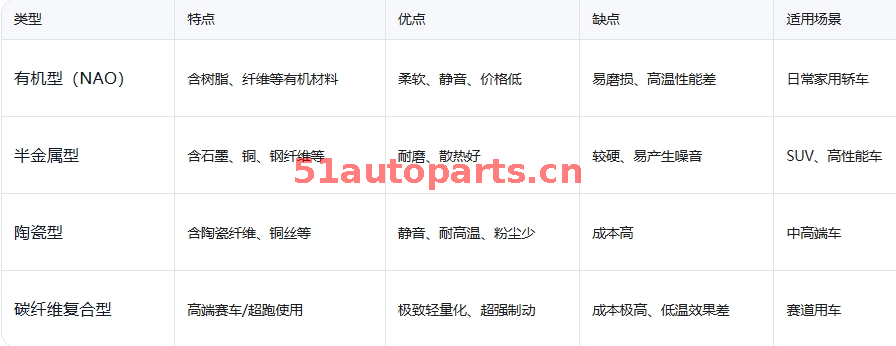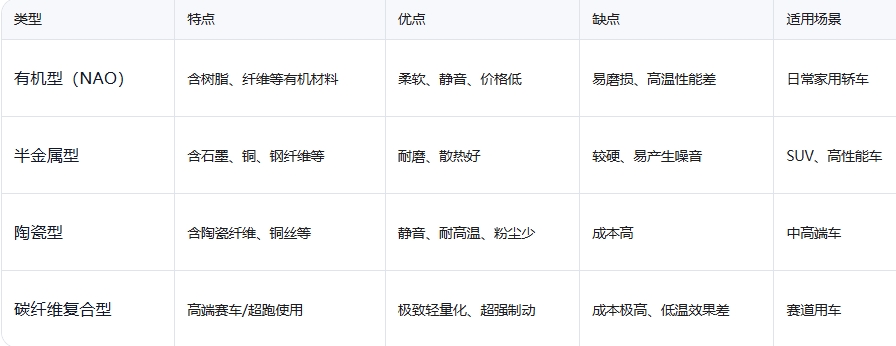What does the D number of brake pads mean? Example of common brake pad size D

A while ago, we popularized the OE related knowledge of automotive parts, which was deeply loved by some netizens and users. Today, we will continue to popularize the D-number information of brake pads in automotive parts, hoping to help more netizens and users.
What is the D number of brake pads?
Let's first take a look, what does the D number on the brake pad represent? Why do some old reporters report the D number of brake pads.
D number "is a numbering method in brake pad products, usually referring to the brake friction material code (Friction Code) or the manufacturer's internal product number.
In some brands, such as Akebono, Textar, Bosch, etc., the D number refers to the formula code for friction materials, such as D182, D609, D1144, etc.
This code represents the type of friction material used for brake pads (including model, semi metal type, ceramic type, etc.), which determines the performance of the brake pads (such as noise, wear rate, braking force, etc.).
Speaking of which, we have to mention the development history of brake pads.
The development history of brake pads
The development of brake pads has roughly gone through the following stages:
Early stage (1900s~1930s)
Using asbestos material as a friction material has low cost and high temperature resistance, but it was later discovered that asbestos is harmful to human health.
Mid term (1950s-1980s)
Introduce non asbestos organic materials (NAO) and semi metallic materials, gradually phasing out asbestos.
Modern (1990s present)
Introducing ceramic materials to enhance noise reduction and wear resistance, adding electronic sensors to achieve automatic alarm function, emphasizing environmental protection, reducing metal content, and lowering dust pollution.
Future Trends
More environmentally friendly and intelligent (such as online monitoring of wear and tear), new material applications (such as nano coatings and composite ceramics).
Types of brake pads
Based on the development history and D-number information above, we can easily classify brake pads.
According to the material and performance, it can be divided into the following categories: machine type (NAO), semi metal type, ceramic type, carbon fiber composite type, etc.

Example of common brake pad size D
Next, let's give some common brake pad D numbers for your understanding.
Akebono (Akebono Brake Company, Japan)
D182: Ceramic formula, suitable for most Japanese cars (such as Toyota Camry, Honda Accord), quiet and low dust.
D609: There is a model formula suitable for light sedans, with an affordable price but fast wear and tear.
D1144: High performance semi metallic formula, suitable for SUVs and pickups, high temperature resistance, strong braking.
D709: Improved ceramic formula for modern/Kia models, balancing comfort and durability.
D1103: Designed specifically for the North American market, suitable for medium to large vehicles such as Ford and General Motors.
Textar (German horse brand group, original supporting Mercedes Benz, BMW, etc.)
D112S: Textar's standard ceramic formula is widely used in models such as Volkswagen and Audi.
D115S: Enhanced ceramic formula, suitable for vehicles with ESP system, with faster response.
D118S: High friction coefficient formula, suitable for high-performance vehicles or frequent intense driving situations.
Bosch (Germany)
D191: Ceramic formula, suitable for Asian models such as Toyota and Nissan, with low noise and low dust.
D1144: Similar to Akebono, used in some SUV models with strong wear resistance.
D112: It has a model formula and is suitable for urban commuting vehicles, with high cost-effectiveness.
D115: High performance semi metallic formula, suitable for German sports car models.
Ferodo (a British brand belonging to the Tennak Group)
D1129: Ceramic formula, suitable for European cars such as Volkswagen and Skoda.
D1139: Semi metallic formula, used for French cars such as Peugeot and Citroen.
D1182: Upgraded ceramic formula, suitable for car owners who value quietness and comfort.
Of course, in the automotive parts market, we mostly use OE numbers and OEM information to query and allocate goods. At present, many overseas companies consult our website and customers when looking for accessories, and we also welcome everyone to join our platform.

